|

Summer
1999 (7.2)
Javad Mirjavad
(1923-1992)
Emblazoned
by the Sun
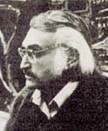 Javad Mirjavad rarely put his thoughts
and feelings on paper with words. Usually, they were emblazoned
across canvases in passionate hues drawn from the sun. Today,
his paintings brighten museum walls in Baku, Moscow, Paris, Rome
and London, as well as the private homes of such celebrated thinkers
as Gabriel Garcia Marquez, Arthur Miller and Chingiz Aytmatov
(Kirghiz writer). Javad Mirjavad rarely put his thoughts
and feelings on paper with words. Usually, they were emblazoned
across canvases in passionate hues drawn from the sun. Today,
his paintings brighten museum walls in Baku, Moscow, Paris, Rome
and London, as well as the private homes of such celebrated thinkers
as Gabriel Garcia Marquez, Arthur Miller and Chingiz Aytmatov
(Kirghiz writer).
The following excerpts from his diary show how Javad's work evolved,
becoming increasingly influenced by African and Latin American
art. With vibrant colors and outbursts of emotion, his paintings
tantalize the senses, much like the foreign sculptures and paintings
he admired from afar.
_____
Excerpts from his diary
Heart
Attack. January [1983]. It seems to me that all the winds blowing
in the Absheron Peninsula 1 sift through the cracks
in the walls and windows in this hospital ward. Even the feelers
on one of the cockroaches are quivering as it meanders across
the wall. At night the cold wind howls like a ghost outside my
window. It was on such a night accompanied by such mournful wails
that my birthday arrived: sixty.
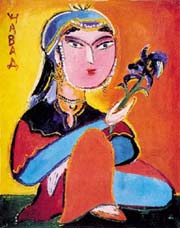  My eyes won't close
in sleep. Thousands of thoughts race through my mind. I have
no visitors. The whole world seems to have forgotten me. No one
needs me. Only my wife - the most pitiful and miserable creature
in the world-is standing watch day and night, guarding me from
the clutch of death. My eyes won't close
in sleep. Thousands of thoughts race through my mind. I have
no visitors. The whole world seems to have forgotten me. No one
needs me. Only my wife - the most pitiful and miserable creature
in the world-is standing watch day and night, guarding me from
the clutch of death.
One day the Devil turned up on the ward. The first words he uttered
as he crossed the threshold were: "God bless you! You don't
look at all like a dying man." But I have died a thousand
deaths in my paintings - to die one more time seems so easy.
Here I am, lying in the filth of this ward. I am not complaining
and criticizing anyone - I've been a happy man. Dying was sure
to happen sooner or later. That's destiny.
Left: Javad Mirjavad, "A
Girl With an Iris", from the series, "Improvisations
based on themes from Eastern Miniatures," 1986.
The most important
thing is that I've never betrayed my conscience. And I never
will. I've lived just as I have wanted to. I have spent most
of my life in nature, enjoying and loving everything created
by God. I've drawn my colors from the sun and copied these blazing
colors on my canvases. I've merged the spirit of my heart and
soul with these colors and produced a considerable number of
paintings. That same spirit continues to win the hearts of viewers
even now. . .
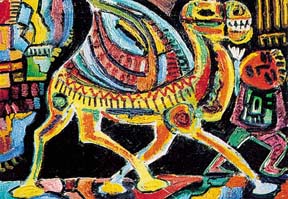  But no one seems eager
to understand my works. The most troubling thing is that they
don't want to. People are sick. They want to be spoon-fed. They
need "art porridge" so that they can swallow it easily,
without effort. People do not understand one another, so how
is it possible for them to fathom the world? . . . But no one seems eager
to understand my works. The most troubling thing is that they
don't want to. People are sick. They want to be spoon-fed. They
need "art porridge" so that they can swallow it easily,
without effort. People do not understand one another, so how
is it possible for them to fathom the world? . . .
Right: "Caravan Driver",
from the series, "Improvisations Based on Themes From Eastern
Miniatures,"1986.
The Devil said: "Do you believe all that nonsense? It's
all a fairy-tale, a legend - and an old and hackneyed one at
that." And I replied: "No, it's not a legend. It's
truth. What about Giordano Bruno [1548-1600] and Van Gogh [1853-1890]
and Arto, who are even closer to us? [Walt] Whitman [1819-1892]
once wrote: "Oh, cruel sun! If another sun like you didn't
rise inside me every day, you would have destroyed me!"
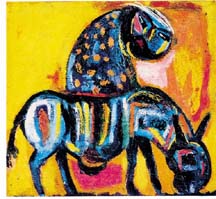  Left: "Watering Place," 1986. Left: "Watering Place," 1986.
Leonardo da
Vinci [1452-1519] once observed: "Millennia will pass. Nothing
will be left of us in this world except the legends that they
have made up about us!" May the legends of Prometheus live
long, but not those of Faust who sold his soul to the devil.
I feel very weak and exhausted after the heart attack. I can't
do a single thing by myself. I won't be able to return to my
former self. The premonition of death chases me.
I fear lest I should not have enough time to realize all the
dreams that I've been cherishing in my heart. It seems to me
that I've been searching for such ideas all my life. Now, finally,
I realize that I can finally paint them with all their nakedness
and tenderness. Now, even a minute wasted away without being
devoted to art is an ordeal for me. Bit by bit, gradually, I'll
give up all my doubts and my spirit will cool down - my spirit
which has always been as fiercely hot and turbulent as a volcano.
I must have been living with all these emotions inside me since
childhood when I used to walk barefoot in my grandfather's garden
in Fatmayi - a village near Baku. It was then that those senses
crept into my blood from the scorching earth of the sun's hot
summer rays and awakened my spirit.
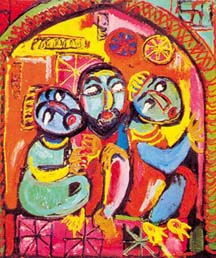  These senses grew together
with me and matured. I have carried them from my youth up until
today. Nothing can stifle these emotions inside me. That's what
has given me strength, bursting forth from my brain. Ever since
I realized that painting was my destiny, I have been working
day and night like a madman. And now look at me - my feet are
hardly able to hold me up. I pray to God, beseeching Him to give
me time to accomplish my final works. These senses grew together
with me and matured. I have carried them from my youth up until
today. Nothing can stifle these emotions inside me. That's what
has given me strength, bursting forth from my brain. Ever since
I realized that painting was my destiny, I have been working
day and night like a madman. And now look at me - my feet are
hardly able to hold me up. I pray to God, beseeching Him to give
me time to accomplish my final works.
Life and Death
Is there
another life beyond this one? Is there another world, ruled by
wisdom or manifested in some other shape? Do other worlds exist?
Everything is relative in life-the world that we can see and
the world that we cannot see. Maybe we return to this world after
our death. In fact, when it seems that we are acting against
our will, it is our memories that are ruling and directing us.
Our ancestors used to explain it perfectly.
I used to "see" one and the same dream repeatedly for
a long time: there were mountain ranges running amidst the sea
along the coast where I grew up. But nowadays not even a small
island exists there. Recently I read in a scientific source that
in the olden days, this region was a junction for the two shores
of the Caspian Sea. Maybe I've seen it myself-not now, but in
a previous life. Maybe my ancestors had seen it and transmitted
it to me through their memories.
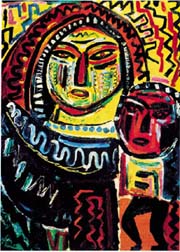  When I first saw one
of my brother's paintings [Tofig Javadov], I became overtaken
by despair; it frightened me so-like a premonition that some
disaster was awaiting our family in the near future. It was later
that I named that canvas "A Note of Mourning". Less
than ten days passed before Tofig met his tragic death in Moscow.2 When I first saw one
of my brother's paintings [Tofig Javadov], I became overtaken
by despair; it frightened me so-like a premonition that some
disaster was awaiting our family in the near future. It was later
that I named that canvas "A Note of Mourning". Less
than ten days passed before Tofig met his tragic death in Moscow.2
Art:"Madonna",
1987.
The world is full of mysteries. And we, like those stone statues
on Easter Island, with eyes fixed eternally on the sky, search
for the key to all those mysteries in the profundity of our own
selves and in the depths of the universe.
We have become completely estranged from nature. We have forgotten
the language with which to communicate with it. We are all fumbling
about blindly. We seem to be constantly on the run in a senseless
way. All this is portrayed by Bosch [Hieronymus, 1450-1516] perfectly
on canvas and also in the book of Ecclesiastes in the Bible.
I remember once I couldn't sleep a wink the entire night, tossing
from side to side in my bed until morning. It was as if some
premonition had seized me. My heart was throbbing with an uneasy
anxiety as though it were whispering "Death, death!"
Not only my heart but everything around me was chanting that
one solemn word. It turned out that on that very night, my brother
lay drowning in his own blood a thousand kilometers away.
The rituals of Siberian shamans tell us more about life and death
than these primitive "realistic" paintings in our exhibitions.
Grasping the meaning and the subject matter of a painting, an
icon, a miniature or an Eastern pattern heightens one's imagination.
It intensifies one's insight of supernatural phenomena. The content
of certain architectural and sculptural monuments, the characteristics
of some metals belonging to the Asian continent, the method of
mummification-all this still remains a mystery.
Long, long ago, our ancestors passing through the Alaska Peninsula
laid the foundation of a great culture overseas. An Asiatic was
searching for the essence of life and he found it. And he could
encapsulate everything that he discovered into only one thing,
which later was named "art"-that is, music, architecture,
dance and poetry. They left us with wise sayings about eternity
and the ephemerality of life. A Turkish-Mongolian legend says:
May the words we utter
Be in harmony with our deeds.
May the Gods we create
Always bear witness to these things.
In our language, the word "rassam" (painter) means
a person who can foretell the future. A painter ranks art, his
creative activity, higher than life itself. Art always precedes
science, opening up broad horizons for thinking and enabling
people to understand themselves and their surroundings. It helps
them to see realities that escape the normal glance of the naked
eye. An artist is a prophet. Painting is not a profession; it
is a gift, given by God.
I completely share the opinion that man is responsible for everything
that happens in his life. Man is a victim who, with his death,
makes up for everything in the interminable progress of life.
Again, let me refer to the Turkish Mongolian legend about Gesser
Khan:
Our muscles are a long way
From the joys of life
But nearer than the delight of death.
We start by crawling on a carpet. It is at that time that the
rich variety of colors and the ornaments of carpets become engraved
in our minds, leaving traces on our memories. Who knows, maybe
our way of thinking as artists is shaped from that time?
Painting teaches me to realize the essence of life. Painting
is both insanity and consciousness at the same time. These two
notions, of course, contradict each other-but only at first.
One more thing-a painter needs a long life, but that's an absurd
idea because an artist expends his life, bit by bit, in his works.
He gradually comes to discover certain realities, and thus consumes
his life in his paintings, living in them. The flames in the
painter's heart, which consume him, light the world which in
turn surrounds him.
Influence of Cezanne
Cezanne led me by the hand to great art. I found well-constructed
color, form and space in his system. With his analytical style,
he made the world more real to me. He didn't substantiate matter-he
personified it. He gave breath to it by revealing its structure.
He could take a common object, penetrate its essence and reveal
its relation to life. Cezanne's constructivism proceeded from
the Renaissance classics' multi-perspective. His color nuances,
as Van Gogh put it, were like Wagner's rich palette of sound.
In those years, Impressionists were not on display in the museums
of the Soviet Union. I went to the Director of the Hermitage
Museum in Leningrad [now St. Petersburg] and told him that if
he didn't allow me to see Cezanne's works, I was going to kill
him. And so I was shown the works.
Thirty years later, I met Piotrovsky in Baku at an archeology
symposium. He knew about the incident. As he didn't have enough
time to visit my studio, I showed him some photos of my paintings.
He went into raptures and exclaimed: "Babylon! Babylon!
It's great art! It's as great as the pyramids of Egypt. It wasn't
in vain that you aggravated the entire Hermitage!" The incident-like
a page in our lives-reduced us to laughter when we recalled it.
African Art
In 1955, for the first time in my life, I saw a reproduction
of African sculpture [Javad was 32 years old at the time]. I
had never seen such plasticity before-measuring systems opposing
each other, such outbursts of feelings and such strange combinations
of different materials-wood, wisps of grass, natural hair, glass,
bone and fabric. For instance, a human figure carved from ordinary
wood was decorated with glass eyes, natural human teeth, pieces
of cloth, making it look rather extraordinary and mystic-like,
rather Sufi-like, existing as a work of art independent of anyone
or anything in this world. It had a life of its own. The aesthetics
of this extraordinary form of art shook me, dwarfing everything
that I had learned from classic European art, which took its
sources of cultural tradition from Mediterranean cultural aesthetics.
To become more familiar with African culture, I often frequented
the public library in Moscow and read many books. But even all
this did not satisfy my thirst. I arranged to go to Leningrad
to visit the Museum of World Ethnography. There I saw African
figures carved from wood, Benin's bronze heads, women's faces,
plainer than reality and women's eyes-wide-open in amazement,
or was it horror? I couldn't keep myself from touching them.
Behind those prominent eyes, I saw man's passionate eagerness
to burst forth beyond his physical confines, to free himself
and merge with the universe. There I also saw the stone statues
of the Oceanic countries, Siberian masks used in shamans' rituals,
Burmese figures, three meters in height, and examples from the
school of Indonesian painting. At that time, an exhibition of
Tibetan icons also opened in Leningrad.
It was as if, finally, I had found myself in a mysterious world
of colors, for which I had been longing for thousands of years!
I went out and bought watercolors and paper and started working.
For days, I worked from morning till night, making sketches,
going through about a hundred pages of Whatman paper.
I returned to Moscow from Leningrad and again headed down to
the public library. There I viewed reproductions of Ajantan's
frescoes [Buddhist rock-cut cave temples and monasteries in western
India], and Central Asian as well as Southeast Asian samples
of art. Again more faces and images. About that time, there was
an exhibition of Mexican art in Moscow. I became fascinated in
their ancient stone sculpture and in the work of contemporary
artists Tamayo [born 1899] and Sikeyros.
Breaking from Tradition
Then I returned to Baku. Again, back to the village of Buzovna
near Baku. I was completely alone for ten years. That's when
I decided to break from European tradition completely. It seemed
all dried up and emaciated and no longer satisfied me. I started
to destroy my paintings and by the time I finished, not a single
canvas was left. I was 35 at the time. I remember thinking that
when Van Gogh had been my age, he had already created all of
his works and was already dead. But I had done nothing yet and
it frightened me. I became very depressed.
I had started painting as had others, early in my youth. So when
I destroyed all my paintings, I had already produced some good
works but not even those were spared from the fire.
I'm not sorry for having destroyed them, though it was wrong
of me. I only regret that I destroyed a different style that
I had created.
Deep passions desperately tore at my inner world affecting my
psyche. I remember walking around like a madman. I had grown
into someone impossible to get along with. To calm myself down,
I often thought of what Van Gogh himself had said, "An artist
is a saint, but at the same time, he's somewhat of a rabid dog."
This process-or metamorphosis-or conversion-must be familiar
to every creative man.
Gobustan
Like all of mankind, I began my path in art from nothing. Gobustan-the
residence of primitive man from the Paleolithic, Mesozoic and
Neolithic periods-became the starting point of my path (1956-57).
Frankly speaking, I didn't so much like the carvings that I saw
in Gobustan; they had looked so much better in reproductions.
But the fear of wild animals, drawn by primitive man, produced
an impression of physical strength.
The site itself was fantastic-mountains and rocks of various
shapes that had undergone tremendous transformation by the winds
even before history had been recorded. I've tried to portray
the spirit of those rocks, volcanoes and mountains, and the dynamic
naturalness of their form. Personally, I've always viewed nature
as the primordial form of existence. I have even felt resentful
that primitive man seemed indifferent to nature.
It was the primitive arts of Gobustan that laid the foundation
of the Middle Ages miniature and plastic arts in terms of its
forms, composition and harmony. I was particularly impressed
by the art of the Neolithic period and those of periods closer
to us. The culture of those ages is very well represented in
the region of Azerbaijan. The primitive artist, not deprived
of the Sufi and abstract way of thinking, skillfully used stone
to create brilliant forms.
While in Buzovna, I produced some women's images on large wooden
boards using tar and enamel. Sometimes I would model different
pictures on a sandy surface, cover them with tar and then decorate
them with pebbles, wood and metal. Sometimes, I would mold various
figures from cement. It was abstract art and did not bear even
the slightest resemblance to European abstract art. I had made
them in nature in the open air in the midst of a strong impulsive
storm of emotions. All those works contained a monumental form
and rich color scheme.
It's a great pity that these works didn't survive-except for
three of them. The boards couldn't bear their weight and broke
while they were being transported to another place. The paint
on some of them cracked and came off, and the tar spoiled the
paint and sometimes cracked and peeled. Some of them were too
heavy for us to carry while moving from one place to another.
As it was impossible to lift them, we buried them and I drew
a map to mark the spot where they were hidden. But alas, I lost
the map. Thus, the destruction of those works was brought about
by my poverty.
The vivaciousness of youth gives rise to the crazy impulse to
perceive everything, to comprehend everything and to taste everything.
Sometimes it is our inexperience that causes us to rise up and
rebel against all the things that seem unfair and unjust in life.
But as time passes and we become more mature and wise about life,
through experiences-both painful and fortunate-we gradually come
to realize that it is not the world that is imperfect or impotent
in the face of the inexplicable mysteries of the universe, but
it is our knowledge that is not profound enough to perceive these
mysteries.
Rooted in the Land
For
me, the Absheron Peninsula, especially the part known as Gobustan,
is a sacred place-a kind of shrine. I'm not saying this because
it is the place where I first opened my eyes to see the sky.
Nor is it because in this small area, you can find sea, mountains,
deserts, volcanoes, temples and ancient graveyards [Sufi Hamid
cemetery] in harmony with each other. Once a Mexican archeologist
reported on this theme and observed: "One can sense hope
for life in those graves, even after death."
Those words are very close to the spirit of my memories about
Absheron. Primitive man lived here and left us pictures for us
to remember him by. But in addition to all this, the most important
thing about this land is its unconquerable spirit. I've roamed
all around and know every inch of this land. It is this land
that has made me an artist and given me patience, fortitude and
loyalty. It is this land that has forged me into the artist that
I have become.
Zardusht [founder of Zoroastrianism, 628-550 B.C.] used to live
here. He left us with songs, tales, stories and legends saturated
with his wisdom. Our people, generation after generation, have
been brought up and educated in this heritage. These people have
always concerned themselves with everything happening in this
world. These people have never stood by and just watched while
important things were happening.
I remember one summer in my childhood, my grandfather, brother
and I were walking to a village. The weather was very hot, as
is usual at that time of year. The vacant fields around us stretched
endlessly. Though we caught a glimpse of a cart in the distance,
it soon disappeared behind the hills. We had walked a long way
under the red, hot, scorching sun when suddenly we saw some watermelons
lying in the middle of the road. We were puzzled. How did these
melons, enveloped in what seemed to be a flaming light, appear
there when all around us was nothing but the throbbing heat?
My grandfather said that the cart owner must have had something
to do with it-that it was his handiwork. Seeing us in the distance,
he must have left the watermelons on the road to make the children
happy.
I will never forget the warmth, the color and the taste of those
watermelon slices that my grandfather cut for us. Nor will I
ever forget that cart owner-even though I have never seen his
face.
This is the first, and most likely the last time that I will
take up my pen to create "literature". Honestly speaking,
this work is not for me.
There is a legend in Ramayan about people gathering wheat left
after it has been harvested. The legend says that these people
gradually melt into the horizon, merging with the sun. In the
end, they themselves turn into the sun. Of course, this is all
meant to be symbolic.
My art is polyphonic-polysemantic and multi-colored. This all
proceeds from my healthy way of thinking and perhaps, from perceiving
the world as a more beautiful place than it actually is. My art
consists of ardent power to perceive the integrity of life and
a healthy bio-psychology. I've always longed to reach the depths
of knowledge so that I might realize something out of these mysteries
of the universe that are beyond human understanding.
Footnotes:
1 Absheron Peninsula is the region where Baku is loca-ted.
The peninsula is sometimes referred to as the head of the eagle
on the Azerbaijan map. As it is surrounded by the Caspian Sea
on three sides, the winds can be ferocious and hence the word
for "Baku" meaning "wind beaten".
2 Tofig, Javad's brother, had poor eyesight and walked
onto some train tracks and was killed in Moscow by an oncoming
train.
3 Gobustan is about an hour's distance west of Baku. It
identifies the region where there are ancient cave drawings that
date back at least 5,000 years.
Javad's wife
may be reached in Baku at (99-412) 39-68-24.
Translated from
Azeri (Cyrillic) by Tamam Bayatly from the journal
Ganjlik (February 1988, 21-24).
From Azerbaijan
International
(7.2)
Summer 1999.
© Azerbaijan International 1999. All rights reserved.
Mirjavad | AZgallery
Artists
|

 Javad Mirjavad rarely put his thoughts
and feelings on paper with words. Usually, they were emblazoned
across canvases in passionate hues drawn from the sun. Today,
his paintings brighten museum walls in Baku, Moscow, Paris, Rome
and London, as well as the private homes of such celebrated thinkers
as Gabriel Garcia Marquez, Arthur Miller and Chingiz Aytmatov
(Kirghiz writer).
Javad Mirjavad rarely put his thoughts
and feelings on paper with words. Usually, they were emblazoned
across canvases in passionate hues drawn from the sun. Today,
his paintings brighten museum walls in Baku, Moscow, Paris, Rome
and London, as well as the private homes of such celebrated thinkers
as Gabriel Garcia Marquez, Arthur Miller and Chingiz Aytmatov
(Kirghiz writer).



